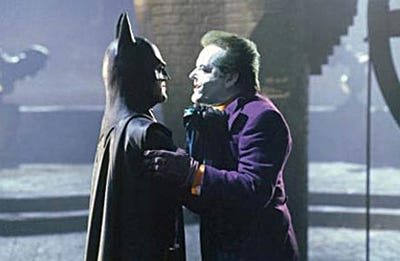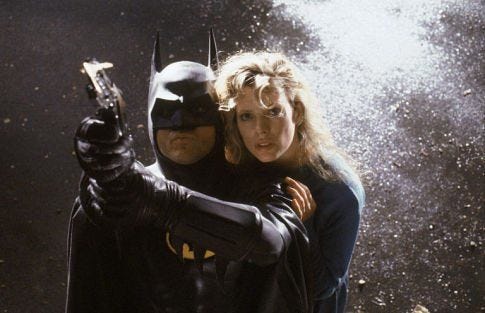The Burton Binge: "Batman"
Each Sunday with “The Burton Binge,” Sam Watermeier will look back at one of Tim Burton’s films, ultimately tracing the return to the auteur’s roots with the October 5 release of “Frankenweenie,” an animated adaptation of Burton’s first live-action short film.

Like many of the characters in his films, Tim Burton is more tolerated than he thinks he is. Ironically, as a self-proclaimed outcast, he continues to exist — and thrive — in the mainstream world.
As his frequent collaborator Johnny Depp said, “I have never seen someone so out of place fit right in. His way” (as quoted in “Burton on Burton”).
The first major Hollywood film Burton directed his way was 1989’s “Batman.” He managed to infuse its surreal comic-book world with raw, human emotion. Beneath its glossy surface, “Batman” is not mere popcorn fare but rather a darkly poetic melodrama. Like all of Burton’s films, it embodies the very definition of ideas in that it is vaguely familiar yet refreshingly original at the same time.
And it would not be a Burton film if the main character did not connect to him. Like Burton, Batman is a walking contradiction. Wearing his strangeness on his sleeve yet somehow blending in to the world around him, the Caped Crusader is every bit a part of Burton as he is of his creator, Bob Kane. Batman and Burton are both “reclusive neurotics who feel they have to prove themselves to a society they do not really inhabit” (Edwin Page, “Gothic Fantasy: The Films of Tim Burton”).
The primary thrill of the Batman films comes from the character’s resistance to estrangement and unexpected placement in certain settings. While Christopher Nolan’s efforts ground the otherworldly warrior in gritty reality, Burton’s films present him as a straight man in a circus of crime. Michael Keaton’s performance even evokes a soldier wading through a gothic funhouse.
With a quirky director at the helm and a comedian by his side, the production itself was every bit as bold and strange as any of the settings in which Batman has been thrust.
But oddly enough, the film doesn’t feel like a jarring experiment. Burton and Keaton slip into their roles with considerable ease, as if they were destined to explore the material. And all the elements — Bruce Wayne’s aching over his parents’ murder, Gotham City’s strange, colorful bursts of crime, etc. — come together more gracefully than they should.
One could argue that “Batman” marks the beginning of Burton’s descent into familiarity, his style’s transformation into a “brand.” But it's not how the film stands out that makes it impressive; it's how it fits in. "Batman" set the standard for all comic-book films to come, seamlessly infusing a surreal landscape with emotional authenticity. It feels less like a radical shift in the genre than simply an example of a comic-book film done right.
The film doesn't even call attention to its emotional heft. It all comes across in Keaton's brooding glares.

Looking back on it now, the love interest (Kim Basinger as Vicki Vale) feels more like a genre fulfillment than a full-fledged match for Batman/Bruce Wayne. But Jack Nicholson's performance as The Joker remains completely riveting, evoking pure comic-book outlandishness without interrupting the film's emotional verisimilitude. The same praise applies to the film's big blockbuster moments, which are just as unexpected, spine-tingling and powerful as the intimate ones.
Herein lies the advantage over Nolan's Batman movies. While his films are certainly infused with emotional realism, they lack the fun-for-all-ages magic of Burton's entries.
"Batman" was a massive hit, but Burton didn't sell out. He followed this universally successful sensation with his most personal film, "Edward Scissorhands," which I will discuss next Sunday. Stay tuned!


